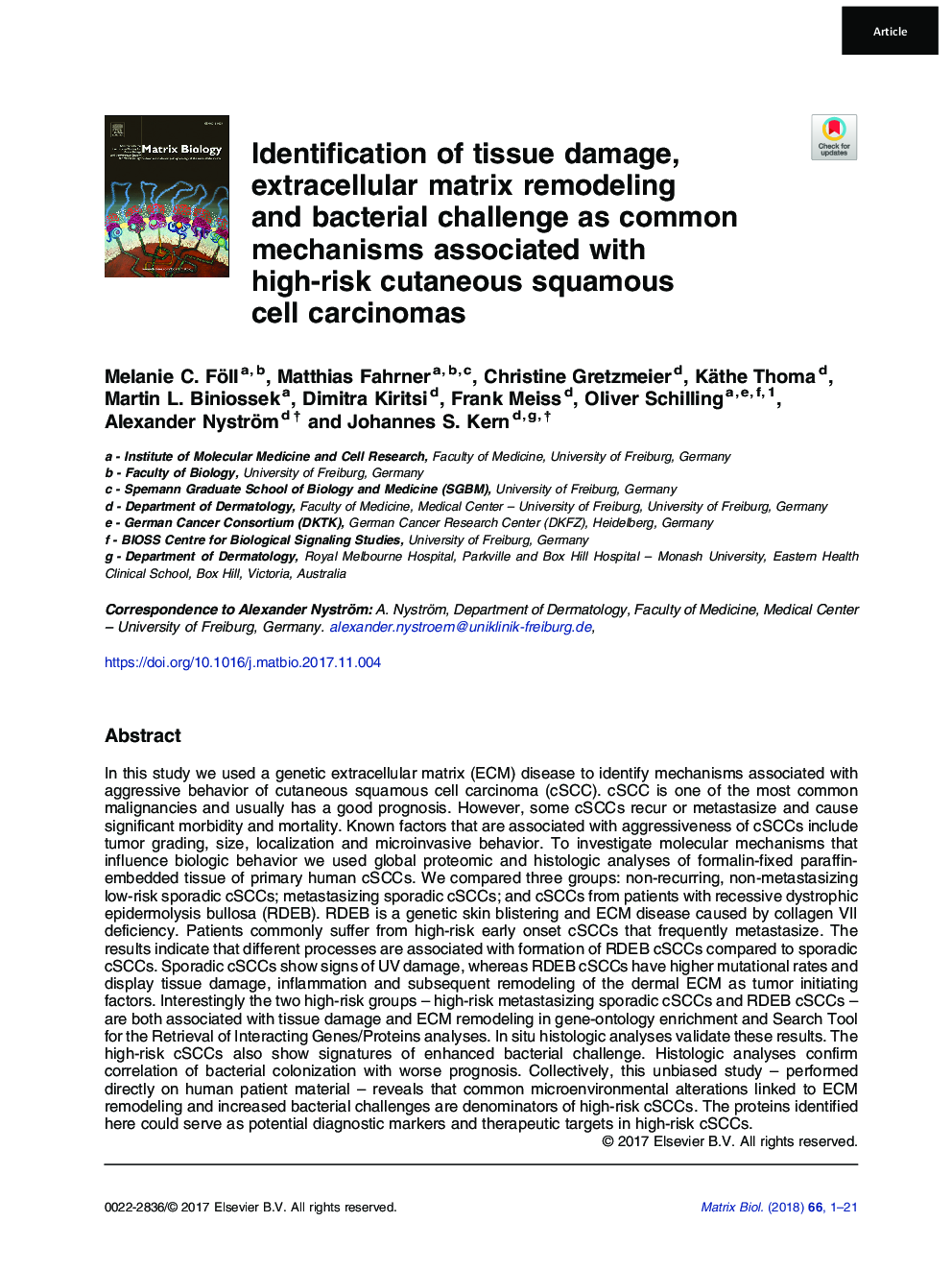| کد مقاله | کد نشریه | سال انتشار | مقاله انگلیسی | نسخه تمام متن |
|---|---|---|---|---|
| 8455074 | 1547996 | 2018 | 21 صفحه PDF | دانلود رایگان |
عنوان انگلیسی مقاله ISI
Identification of tissue damage, extracellular matrix remodeling and bacterial challenge as common mechanisms associated with high-risk cutaneous squamous cell carcinomas
ترجمه فارسی عنوان
شناسایی آسیب بافت، بازسازی ماتریکس خارج سلولی و چالش باکتری به عنوان مکانیزم های مشترک در ارتباط با کارسینوم سلول سنگفرشی پوستی با خطر بالا
دانلود مقاله + سفارش ترجمه
دانلود مقاله ISI انگلیسی
رایگان برای ایرانیان
کلمات کلیدی
RDEBXRCC5LIMMAmyristoylated alanine-rich C-kinase substrateSND1STRINGLFQNMSCECMCSCCMARCKSDAPICAFAPCs4′,6-diamidino-2-phenylindole - 4 '، 6-دیامیدینو-2-فنیلینولFFPE - MEPsearch tool for the retrieval of interacting genes/proteins - ابزار جستجو برای بازیابی ژن / پروتئین های تعامل استdystrophic epidermolysis bullosa - اپیدرمولیز دیستروفی قلبیInvasion - تهاجمEMT - تکنسین فوریتهای پزشکیNon-melanoma skin cancer - سرطان پوست غیر ملانومRecurrence - عودformalin-fixed paraffin-embedded - فرمالین ثابت پارافین تعبیه شده استcancer associated fibroblast - فیبروبلاست وابسته به سرطانExtracellular matrix - ماتریکس خارج سلولیMetastasis - متاستاز cutaneous squamous cell carcinoma - کارسینوم سلول سنگفرشی پوستیcollagen VII - کلاژن VIILabel-free quantitation - کمترین مقدار برچسبEpithelial-mesenchymal transition - گذار اپیتلیال-مزانشیمیrecessive dystrophic epidermolysis bullosa - گلودرد اپیدرمولیز دیستروفی خونی
موضوعات مرتبط
علوم زیستی و بیوفناوری
بیوشیمی، ژنتیک و زیست شناسی مولکولی
تحقیقات سرطان
چکیده انگلیسی
In this study we used a genetic extracellular matrix (ECM) disease to identify mechanisms associated with aggressive behavior of cutaneous squamous cell carcinoma (cSCC). cSCC is one of the most common malignancies and usually has a good prognosis. However, some cSCCs recur or metastasize and cause significant morbidity and mortality. Known factors that are associated with aggressiveness of cSCCs include tumor grading, size, localization and microinvasive behavior. To investigate molecular mechanisms that influence biologic behavior we used global proteomic and histologic analyses of formalin-fixed paraffin-embedded tissue of primary human cSCCs. We compared three groups: non-recurring, non-metastasizing low-risk sporadic cSCCs; metastasizing sporadic cSCCs; and cSCCs from patients with recessive dystrophic epidermolysis bullosa (RDEB). RDEB is a genetic skin blistering and ECM disease caused by collagen VII deficiency. Patients commonly suffer from high-risk early onset cSCCs that frequently metastasize. The results indicate that different processes are associated with formation of RDEB cSCCs compared to sporadic cSCCs. Sporadic cSCCs show signs of UV damage, whereas RDEB cSCCs have higher mutational rates and display tissue damage, inflammation and subsequent remodeling of the dermal ECM as tumor initiating factors. Interestingly the two high-risk groups - high-risk metastasizing sporadic cSCCs and RDEB cSCCs - are both associated with tissue damage and ECM remodeling in gene-ontology enrichment and Search Tool for the Retrieval of Interacting Genes/Proteins analyses. In situ histologic analyses validate these results. The high-risk cSCCs also show signatures of enhanced bacterial challenge. Histologic analyses confirm correlation of bacterial colonization with worse prognosis. Collectively, this unbiased study - performed directly on human patient material - reveals that common microenvironmental alterations linked to ECM remodeling and increased bacterial challenges are denominators of high-risk cSCCs. The proteins identified here could serve as potential diagnostic markers and therapeutic targets in high-risk cSCCs.
ناشر
Database: Elsevier - ScienceDirect (ساینس دایرکت)
Journal: Matrix Biology - Volume 66, March 2018, Pages 1-21
Journal: Matrix Biology - Volume 66, March 2018, Pages 1-21
نویسندگان
Melanie C. Föll, Matthias Fahrner, Christine Gretzmeier, Käthe Thoma, Martin L. Biniossek, Dimitra Kiritsi, Frank Meiss, Oliver Schilling, Alexander Nyström, Johannes S. Kern,
